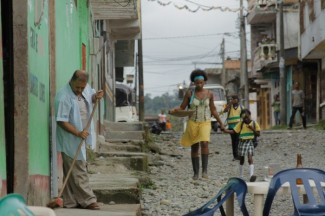Choco (Jhonny Hendrix Hinestroza, 2012): Colombia
 Reviewed by Kimberly Howard . Viewed at The Metropolitan 4, Santa Barbara International Film Festival, 2013
Reviewed by Kimberly Howard . Viewed at The Metropolitan 4, Santa Barbara International Film Festival, 2013
Choco is a Colombian film which tells the story of a woman’s endurance and resilience against the ongoing domestic violence she suffers from her husband. Choco, played by Karent Hinestroza, easily portrays her character’s strength of spirit and holds an unrelenting grasp on the hope for a better life that remains visible throughout her actions in the movie. A plus for the new-comer since the subject material is at times graphic and invasive. Though the subject matter is a serious one, the director gave away clues to the ending practically straight away, that the remaining scenes of the story seemed dragged out to say the least, repetitive at most. Yet, the movie was impactful enough to keep the audience hopeful with the protagonist and cheer her on.
Choco’s husband constantly drinks and gambles in the streets of Colombia and walks around in a drunken stooper half the time. Choco is the worker of the family and instills values to her two young children. In a scene where her young daughter mouths off to a boy in their circle of friends, Choco disciplines her and says not to show disrespect to anyone despite what is done to you. The cinematography of the movie beautifully assists in telling the journey Choco takes everyday as she goes to work. The wide shot of the green landscape fills the screen for the viewer to make out Choco in the distance and gives the sense of her seemingly endless journey between her oppressed home life and the daily routine of going to work.
Choco’s deadbeat husband spends all day gambling away her hard earned money and when he returns home late each night, just like a beast, he takes what he wants from her physical body. Choco’s reluctance and disinterest are not even acknowledged and she remains lifeless and her tolerance level begins to become replaced with a plan and idea of how to break free and begin a better life for her and her children. This is where the chronology of the story seems repetitious because it is the same actions over and over and the viewer is left to wonder if there is any moving forward or breakthrough. At times confusing, this frustrated storyline deals a final blow before the final blow. In an attempt to stand up for herself when she learns her husband stole her son’s school money, which she really saved up for her daughter’s belated birthday cake, her husband strikes her hard down onto the ground. This is an impactful scene, because it reveals the
lack of integrity of her husband’s gambling buddies since no one aides in her rescue. More importantly conveyed is how Choco lays face down in the dirt for a good minute without moving. This delay in her motivation gave more power to her as seen in the heaviness involved in raising herself upright. She then immediately goes to the tienda to pay for her daughter’s birthday cake by having sex with the owner. This is the final demeaning act that wakens her spirit to have the courage to do what she does in the final scene of the movie. The ending, that was told before hand by showing a burning hut, is most graphically surprising that you can’t even believe what you’re seeing! The act was joked about in the beginning of the movie within a circle of women who left their abuser as a means in which to get revenge, and that is exactly what Choco does in the end that literally takes a bite out of her plight.
About this entry
You’re currently reading “Choco (Jhonny Hendrix Hinestroza, 2012): Colombia,” an entry on Student Film Reviews
- Published:
- 02.17.13 / 1am
- Category:
- Films, Santa Barbara Film Festival 2013
No comments
Jump to comment form | comments rss [?] | trackback uri [?]